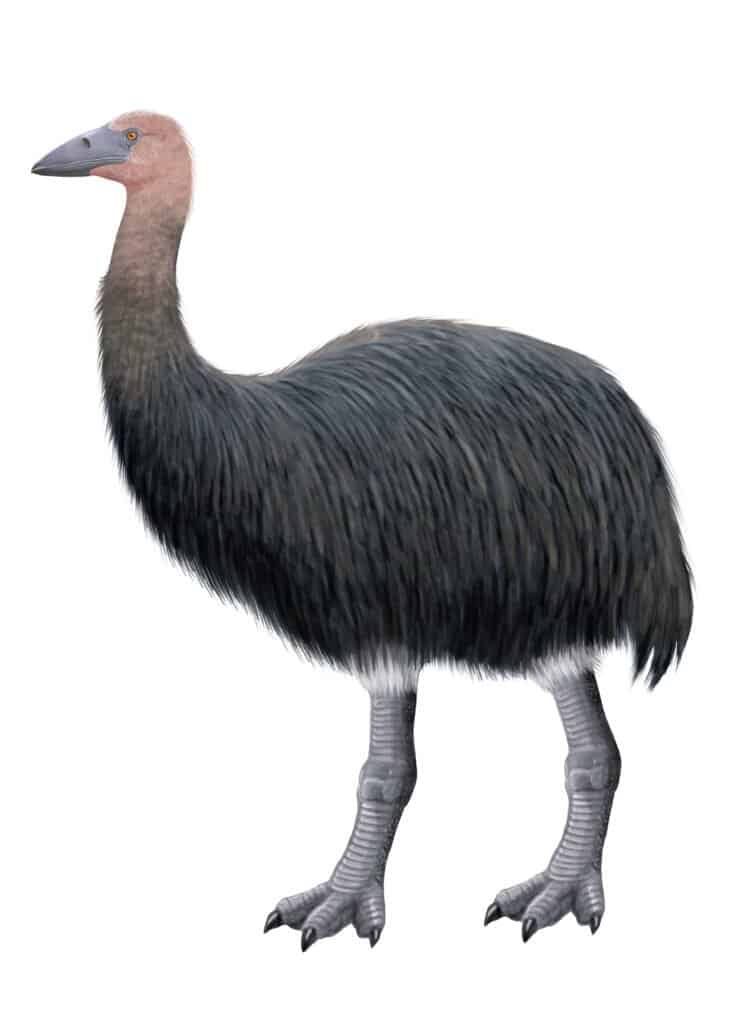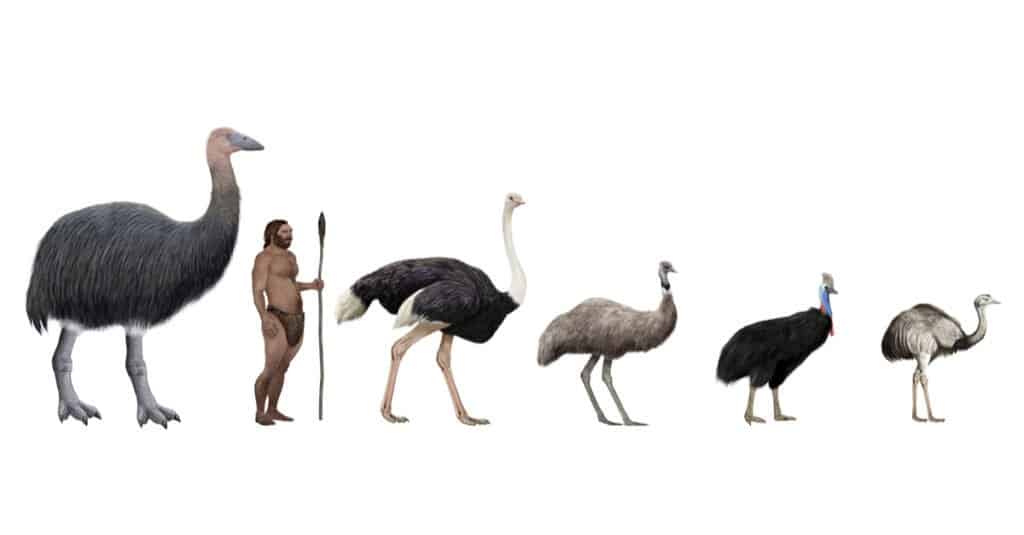The age of the dinosaurs is known for having some of the largest and most fearsome beasts to have ever lived. Therefore, it might be surprising to find that the largest bird wasn’t existent during the time of the dinosaurs but actually lived relatively recently. What’s even more surprising is that this giant weighed more than half a ton but managed to get to that size eating only fruit and seeds! So join us as we discover the largest extinct bird in the world!
The Largest Extinct Bird

The Vorombe titan was the largest bird ever.
©Nicolas Primola/Shutterstock.com
The largest extinct bird in the world is the massive Vorombe titan which was almost 10 feet tall and weighed up to an incredible 1,600 pounds. With a name that literally means “big bird,” the Vorombe titan is both the largest and the heaviest bird to have ever existed. This bird was a flightless bird that was endemic to Madagascar and became extinct around 1,000 years ago. Despite the vast difference in size, their closest living relatives are actually kiwis, which are only the size of chickens.
The Vorombe titan is a member of the family group Aepyornithidae, which are commonly known as elephant birds, of which there are around ten known species across three genera. As they were flightless, they are ratites. This means that they lacked a keel on their sternum – an extension of the breastbone. From that, they could not have flown, as they lacked anything with which to anchor their wing muscles. Despite this, they had large, powerful beaks and strong, stocky legs with large claws to support their immense weight.
For around 10,000 years, Vorombe titans roamed the forests, woodlands, and grasslands of Madagascar – eventually coexisting with humans. Little is known about their diet. However, it is thought that they ate fruits and seeds from various species of palm trees. Despite their extraordinarily large size, they were relatively peaceful birds that posed little threat to anyone, given their herbivorous diet.
As is to be expected, they also laid the largest eggs ever known. Their eggs were between 10 and 13 inches long and 7 to 10 inches wide. Despite being endemic to Madagascar, eggs have turned up as far away as Australia and India. This surprising occurrence has been put down to them having drifted across the ocean.
What Happened to Elephant Birds?
As we’ve already mentioned, Vorombe titans co-existed with humans on the island of Madagascar. Unfortunately, their extinction was a result of human activity. Although humans and elephant birds had lived alongside each other for thousands of years, around 1,000 years ago, the elephant birds became the subject of continued and sustained hunting. Tool marks on elephant bird bones dating back thousands of years show that humans had long hunted them. However, the increased activity around 1,000 years ago, coupled with a massive loss of habitat eventually forced the giant birds to extinction.
As well as hunting, humans began to burn huge swathes of forest to make room for crops. This destroyed their natural habitat and their source of food. Not only that, but it pushed them into smaller and smaller areas which eventually could not sustain the population. Additionally, there are signs that eggs were also vulnerable as evidenced by eggshells near the remains of fires. Given their massive size, they would have been a prized possession as they could have fed an entire family. Despite this, it’s actually not known exactly when elephant birds died out – only that it was around 1,000 years ago.
The Heaviest Flying Bird
Rewind six million years to a time when massive rhinos and three-toed horses roamed the land and we can find the largest flying bird. Although the Vorombe titan holds the record as the largest extinct bird, Argentavis magnificens ruled the sky. With an impressive wingspan of around 22 feet and weighing up to 160 pounds, they were the heaviest flying birds in the world. Although Pelagornis sandersi beat them for wingspan by a couple of feet, Argentavis was undoubtedly the bigger-bodied of the two.
Argentavis magnificens – also known as the Giant Teratorn – lived in Argentina during the Late Miocene era (11 to 5 million years ago). Their humerus bone was only slightly shorter than an average adult human arm. As their wings weren’t really suited to constant flapping, they flew mainly by soaring. They also had sturdy legs and large feet which were able to support their immense size on the ground. They had a slender bill with a hooked tip. Argentavis magnificens largely ate carrion and small mammals which they swooped down to seize without landing. Their biggest rival for food is believed to be the fearsome “terror birds” which were apex predators. Terror birds were flightless birds comparable in height to Vorombe titans but not as heavy (reaching around 1,000 pounds).
How do Birds Today Compare?

Elephant birds were much larger than any bird alive today.
©Nicolas Primola/Shutterstock.com
While the Vorombe titan is without a doubt the largest extinct bird, how do they compare with the birds of today?
As it happens, the Vorombe titan is also the largest bird that has ever existed. The closest bird alive today which compares with them is the ostrich. However, although they are comparable with Vorombe titans in height, they are nowhere near as heavy. Ostriches can reach up to 9 feet tall, but they only reach a maximum of 308 pounds. Although this is much heavier than any other bird alive today, they are complete lightweights in comparison to the Vorombe titan.
The same principle goes for flying birds too – nothing alive today is as big or as heavy as the largest flying birds in the past were. The wandering albatross is the largest flying bird and has the largest wingspan of any living bird today. Their wingspan is typically between 8ft 3in and 11ft 6in, although the largest verified wingspan was 12ft 2in. They are also relatively light birds, weighing only 14 to 24 pounds. However, the heaviest flying bird alive today is the great bustard. Great bustards weigh between 13 and 40 pounds and have a wingspan of between 6ft 11in and 8ft 10in.
Given the sizes of birds today, it would seem as though the true giants of the avian world are likely to remain in the past.
Read More:
10 Extinct Birds in North America.
The photo featured at the top of this post is © YuRi Photolife/Shutterstock.com
Thank you for reading! Have some feedback for us? Contact the AZ Animals editorial team.






